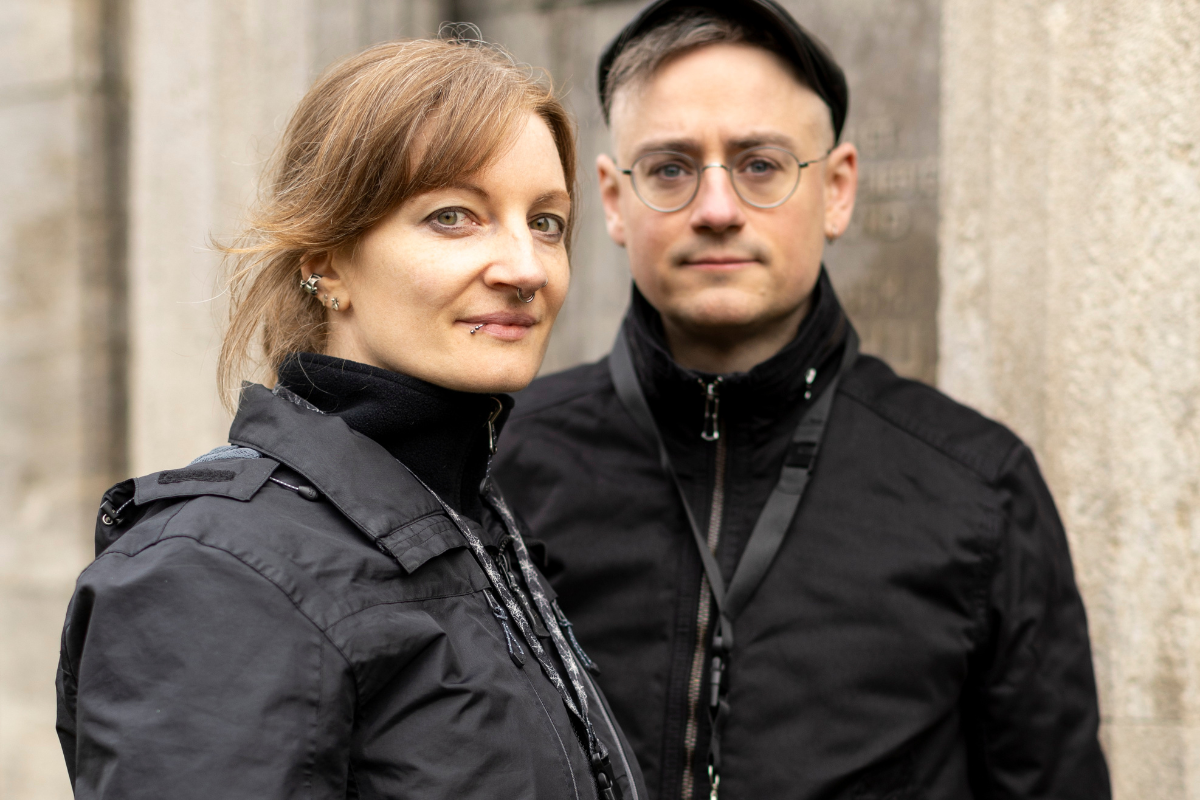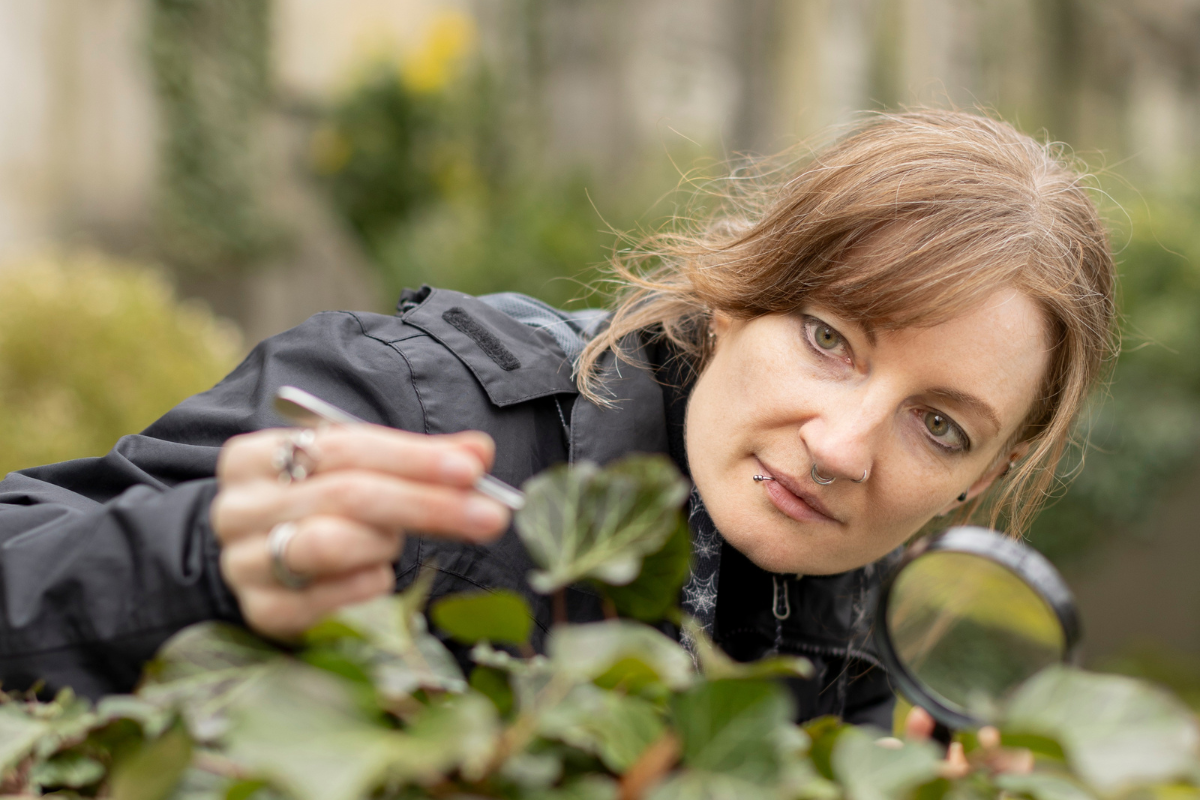Katharina and Parm von Oheimb are united in their enthusiasm for slimy molluscs. They search for snails and slugs in Berlin’s cemeteries to gain new insights into their diversity and way of life.
This article was first published in our journal Für Natur (issue 9/2024).
Katharina von Oheimb crouches in a bed of ivy between old graves and carefully lifts leaf after leaf with tweezers, checking to see if one of her research objects is sitting on the underside. The damp weather is perfect. On grey days like this, she loves to wander through Wilmersdorf cemetery. Together with her partner in research and life, Parm von Oheimb, she searches for slimy molluscs belonging to the class Gastropoda, meaning "stomach foot", or in other words: snails and slugs.
With their high leather boots and blue toolbox, the two could be mistaken for a kind of special task force. A charmingly smiling one, however, whose mission is not death, but life, which finds its niches here among the gravesites. Their research subjects often live in secret, sliding around among leaves and stones, in crevices and cavities. Many snails are only a few millimetres in size, so people hardly notice them.
‘With their moist, dry, open, and overgrown areas, cemeteries offer a valuable mosaic of habitats for snails and slugs,’ says Parm. ‘And the gravestones form artificial rocks that some species like.’ Where they feel at home, their predators can also be found, such as hedgehogs, common toads, slowworms, mice and birds. Especially in tranquil cemeteries. ‘They are amazingly lively places if you take a closer look,’ says Katharina.
To investigate the diversity of snails and slugs in Berlin's cemeteries, the two biologists launched the project "Leben zwischen Gräbern" in 2022. Since then, they have systematically combed through five cemeteries in Berlin during pilot studies and recorded 35 snail and slug species there. These include common species such as the grove snail with its distinctive banding pattern, but also rare and sometimes threatened species. In future, they want to examine many more of the about 200 cemeteries in Berlin.
Crawling among graves
Katharina has marked out an area of around 20 square metres with white and red marker sticks: the study site. They note what they find there on data sheets and analyse some of it in the lab. "We try to collect empty shells or photograph animals wherever possible, but we also take live specimens with us," says Katharina. Very small snails, for example, which they catch with soil samples and detect under the stereo microscope, or slugs, where the reproductive organs have to be examined in order to identify them.
Katharina has found a Draparnaud's glass snail – Oxychilus draparnaudi. "It lives hidden in the leaf litter and feeds on other snails," she says and places the harmless-looking animal, which is the size of a thumbnail, back in the litter. Shortly afterwards, it extends its tentacles. Katharina turns back to the ivy and a little later finds a girdled snail lying on the ground. It is an empty shell with bite marks. The animal was probably preyed upon by a predatory beetle; a mouse would have cracked open the shell on one side instead of breaking it in a spiral along the coiling. "We can use such observations to draw conclusions about interactions in the ecosystem."
The girdled snail, which is native to Italy and was unknown to the region until recently, was detected by Katharina and Parm for the first time in Berlin cemeteries in 2022. A subsequent analysis of citizen science data revealed that the species had been photographed in Berlin already in 2019. "It is now one of the most common snail species at Wilmersdorf cemetery," says Katharina. "It may compete with native species, but does not displace them so far."
Objective of the cemetery project is not just to record the diversity. It also aims to find out why certain species are distributed somewhere within cities and somewhere else not - and which factors influence such patterns: the location of the cemetery, for example, whether it is isolated by roads and buildings or located at a green corridor, how long it has existed and how it is managed. "There are still huge gaps in our knowledge about the ecology of land snails and slugs," says Parm. "We are trying to make a contribution to closing some of them."
A love for the slimy and bizarre
When Katharina or Parm talk about snails, you can hear an enthusiasm that not many people have for these slimy little creatures. They don't feel disgust. For both of them, snails are rather wonder animals. "They are an evolutionarily very successful group of animals that has evolved in many ecological niches; snails can even survive in deserts," says Parm.
And they have developed very special traits. For example, there are slugs that mate while hanging closely together from a mucus thread. And among marine snails there are such that suck the blood of fish or even paralyse them with a venomous dart and eat them. And German cemeteries are also home to the blind snail Cecilioides acicula, which nibbles on human bones in the soil to obtain calcium carbonate for building its shell.
It was the practical inorganic chemistry course for biology students that brought Katharina and Parm together. They met for the first time during their undergraduate studies at the Justus Liebig University Giessen. "We realised that we had very similar interests, soon we were both working on molluscs and also became a couple," says Katharina. From then on, love and research went hand in hand. They completed their doctorates with the same supervisor and moved to London in 2015. There they began to focus on land snails at the Natural History Museum. As snail experts, they came to the Museum für Naturkunde Berlin in 2019 to take part in a project to record biodiversity in Vietnam (see journal für Natur, edition 7).
They participated in two expeditions to Southeast Asia, combed through the rainforest – and found 116 snail species in the jungle of Cuc Phuong National Park alone, including more than 30 presumably yet unknown species, which they are now analysing further anatomically and genetically so that they can be described as new species.
The idea for the Berlin cemeteries came to them during the coronavirus pandemic. They wanted to start a project on their doorstep. It was no coincidence that they turned to burial sites of all places. After all, they both share a passion for the bizarre and morbid. They have already organised an exhibition on animals that were considered messengers of death in popular belief. And since 2012, they combine in their blog cultural-historical observations on death and transience with scientific knowledge, describe unusual burial rites, report about visits to peculiar curiosity cabinets or macabre phenomena in the animal world.
On this dull spring day, Katharina and Parm continue walking through Wilmersdorf cemetery, past freshly decorated and overgrown graves to the flowering meadow by the former crematorium, where Katharina discovers the moss chrysalis-snail, a rare sight in Berlin. It is so small that probably almost everyone in this city would have overlooked it.
Text: Mirco Lomoth
Pictures: Pablo Castagnola


